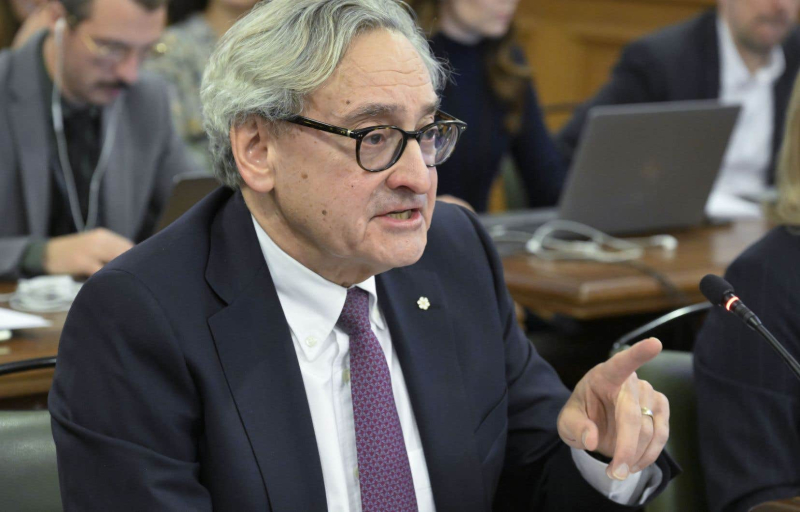Jacques Boissinot The Canadian Press Michael Sabia began its appearance in the parliamentary committee by explaining to the deputies that it will be necessary to be bold in adding infrastructure which will allow an increase of 8,000 to 9,000 megawatts in the capacity of the state company.
The availability of labor is the most important challenge on the difficult path of Hydro-Québec's titanic development plan, which will have to invest tens of billions of dollars to increase its electricity production by 2035 , declared its president and CEO, Michael Sabia, on Thursday.
The CEO. began its appearance in the parliamentary committee by explaining to the deputies that it will be necessary to be bold in adding infrastructure which will allow an increase of 8,000 to 9,000 megawatts (MW) in the capacity of the state company.
“The best moments of our history were marked by the audacity, the courage, of the great builders,” he declared.
Also read
- Hydro-Québec unveils an “ambitious” energy transition plan
- Fitzgibbon convinced of being able to finance Hydro-Québec projects
< /ul>
In his presentation, Mr. Sabia insisted on the importance of investing in the energy transition to break away from fossil fuels.
“This is a real breakup and it wouldn’t be easy,” he said. And those who thought it would be easy? Think about it even more. »
Mr. Sabia gave the example of the United Kingdom, Germany and the United States, whose budgets for the energy transition range from 600 billion to 7.5 trillion dollars by 2035.
« This is no time for half measures,” he said.
Funding for Hydro-Québec projects, which could require investments of $100 to $185 billion by 2035, will be easier to find than the 35,000 workers to be hired for their completion.
“Labor is the most difficult challenge,” he added.
Changes will need to be made to accelerate training, coordinate jobs, integrate workers and give them the best possible tools, he said.
Otherwise, “it is the next generation that will pay the price,” warned Mr. Sabia.
In a press briefing, the Minister of the Economy, Pierre Fitzgibbon, admitted that the scarcity of labor could increase hourly rates, which would have an effect on Hydro-Québec's service costs.
“The number one challenge is access to labor,” he confirmed.
Rates
Then questioned about the effect of Hydro-Québec projects on the rates paid by subscribers, Mr. Sabia affirmed that by 2035, interest rates, financial arrangements for projects and labor will each have their impact.
“Another very important element is the impact on our operating costs of the price of labor. The availability of labor remains an issue and also the price […], which could have a significant impact on our operating costs. »
Subsequently relaunched, Mr. Sabia affirmed that his action plan, which runs until 2035, relies on maximum increases of 3% in residential rates, as capped by the government caquiste.
“It’s a guess on our part,” he said.
Mr. Sabia said he was unable to specify what increases the commercial sector is exposed to due to uncertainties surrounding inflation.
“In general, do we think there will be an increase at one certain level for our business customers? In our opinion, yes, it is very likely. »
In general, do we think there will be an increase at some level for our business customers? In our opinion, yes, it is very likely.
— Michael Sabia
For his part, Mr. Fitzgibbon maintained that he did not foresee an increase in the foreseeable future tariffs beyond the rate of inflation or the maximum of 3% planned until 2025 by his government.
As he prepares to table an important bill affecting the activities of Hydro-Québec, the minister affirmed that this ceiling is a given.
“Mr. Legault’s 3% is sure to be respected,” he told journalists. How are we going to enshrine it? Are we going to put the 3% in the law? Probably not. We have to find the mechanism. »
Mr. Fitzgibbon reiterated that if Hydro-Québec's service costs increased from 3% to 5%, there would undoubtedly be tariff repercussions.
“It may be more expensive for businesses », he mentioned.
Nuclear and breakdowns
Hydro-Québec's plan is based in particular on an increase in energy efficiency, the modernization of hydroelectric power stations and wind power.
The state company has also started thinking about nuclear energy , an avenue that Prime Minister François Legault had closed, citing a lack of social acceptability.
Mr. Sabia in turn underlined this aspect on Thursday, after mentioning a study by the firm SNC on the potential of the Gentilly-2 power plant, which is no longer active.
This possibility, however, remains among the reflections of the state corporation, indicated the president and CEO.
“We are interested in the future in small modular reactors for certain locations in Quebec,” he said. But that's not part of the plan. »
Regarding the construction of dams, Mr. Sabia said that if it is carried out, it will most likely be in partnership with an indigenous community. He reiterated that no dam would be built without social acceptability.

